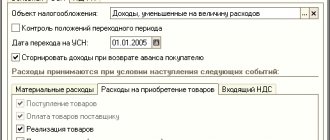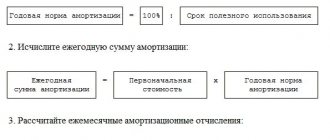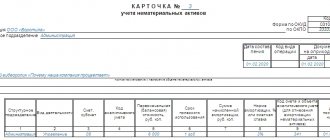Amortization of intangible assets (IIA) largely depends on their useful life or regulated period of operation, which is one of the most important indicators.
Considering that intangible assets, by definition, do not have physical expression, but can generate economic benefits throughout their useful life (UPI), establishing the specific duration of this period often turns out to be a real problem for the management of the copyright holder enterprise.
Often, specialists have a question about how to correctly assign an IPI for a particular intangible asset - an organization’s online resource, its business reputation, an inventive patent.
In addition, the owner of intangible assets needs to know how to act correctly in a situation in which it is not possible to establish an exact service life for a specific property object.
What are intangible assets
From the name it follows that this is an asset devoid of a physical, tangible form. It can bring commercial benefits to the company and has been used by it for more than a year.
Examples of intangible assets:
- trademarks;
- literary, cultural, scientific works;
- business reputation;
- Internet resources of the company involved in the production process, etc.
The following do not apply to intangible assets: financial investments, organizational expenses incurred during the formation of a company, material media of intangible assets themselves (for example, flash drives containing software records).
SPI of intangible assets and legal framework
Acceptance of the specified objects for accounting entails the need to calculate the period during which they will be used. According to PBU 14/07 (Chapter IV), SPI is the period of time during which the company plans to use intangible assets in order to obtain financial benefits.
SPI is calculated monthly. The value of this indicator is influenced by the following factors:
- the period during which the company intends to use the intangible assets;
- the period during which the company has the rights to use the intangible asset or the transfer of control over it occurs.
If the properties of an asset do not make it possible to determine the period reliably, it is recognized as uncertain. Such an object is not subject to depreciation.
Attention! SPI cannot be less than 12 months old, otherwise the object does not meet the criteria for intangible assets (see PBU 14/07).
Business reputation is also an intangible asset. Any business reputation is amortized over a 20-year period (see PBU 14/07, clauses 43.44).
In tax accounting, SPI intangible assets begin to be calculated from the moment it is put into operation. It is necessary to take into account the validity periods of certificates, patents, and other restrictive documents (Article 258-2 of the Tax Code of the Russian Federation). It is advisable to take into account the specifics of contracts for certain intangible assets.
If it is not possible to reliably determine the SPI, the “10 years” indicator is used.
Firms are authorized to arbitrarily establish PPI of assets relating to exclusive rights:
- for programs, electronic databases;
- for an industrial model, sample, invention;
- on the use of integrated circuit configurations;
- for work in the field of selection;
- for know-how, secret technologies, formulas.
The period, according to the Tax Code, is set at two years and above.
What it is?
The regulated useful life of intangible assets is considered to be a set period of time during which the legal owner is expected to receive certain economic benefits (additional income, increased profit) from its practical use.
For accounting purposes, the useful life may be expressed in the number of months (years) of future operation of the relevant asset. In order to amortize an intangible asset in accounting, it is necessary to clarify its SPI.
In tax accounting, however, intangible assets with a cost of more than one hundred thousand rubles can be legally depreciated even in cases where it is not possible to reliably determine their specific service life.
It is noteworthy that the very fact of reliably establishing the useful life or the impossibility of accurately determining it must be clearly recorded both in accounting and in tax accounting.
The uncertainty of the service life is officially stated by the enterprise in the event that the properties and characteristic features of a given asset do not allow its owner to reliably and accurately determine the duration of the relevant period.
In accounting, as mentioned earlier, an intangible asset with an indefinite useful life cannot be amortized.
An important nuance is that the period of use of a particular intangible asset should not be less than twelve months, since this contradicts the key criteria for recognizing the corresponding asset, provided for by PBU/14/2007.
In this case, the duration should not exceed the period of activity of the copyright holder company.
Intangible assets with uncertain SPI
It should be noted that establishing the service life for an intangible asset based on the period of validity of the organization’s exclusive rights to the relevant assets is allowed only for those objects in respect of which the right holder has drawn up appropriate security documents (as an option, patents, certificates, other papers).
If the owner of the intangible asset does not have such securities, the duration of the service life for such an asset is determined by the enterprise in accordance with the expected period of use of the object, during which it is planned to receive specific economic benefits.
If this option is not possible, the period will be considered indefinite.
How to determine it in accounting?
The period is established directly when the corresponding asset is entered into accounting.
Determining the specific duration of SPI for objects in accounting is necessary for the subsequent calculation of their depreciation.
If the period turns out to be indefinite, it will not be possible to amortize it in the accounting sense.
If we are guided by the current standards of PBU/14/2007, the useful life of a specific intangible asset is determined by the following significant parameters:
- the length of time during which the copyright holder enterprise intends to use the intangible assets for their intended purpose and, as a result, receive the expected financial benefit;
- the duration of the time period during which an enterprise that legally owns a non-current asset has the corresponding rights or legal ability to control the object (in other words, the regulated period of validity of the organization’s legal rights to a specific intangible asset).
Accounting requirements regulate the annual revision of the IPI for intangible assets. Thus, an adequate change in the accounting life of an asset is necessary if a significant reduction/increase in the time duration of its useful life is expected.
Each fact of revision of the period of application of intangible assets is recorded in documents.
In addition, if an object at an enterprise was previously classified as an asset that does not have a definite service life, it should be audited annually in order to clarify the possibility of establishing a useful life period for it.
How is it established in tax accounting?
In accounting regularly carried out at an enterprise for taxation of earned profits, the duration of the period of use is established immediately when it is put into effect.
The validity period of protection documents, the parameters of concluded agreements, as well as other conditions limiting the duration of the joint venture are taken into account.
For certain types of intangible assets, arbitrary establishment of service life is allowed, the duration of which, however, should not be less than two years.
We are talking about the exclusive rights of the enterprise to breeding developments, the use of topological layouts for integrated circuits, useful patterns, industrial samples, inventions, databases, software, as well as the possession of information that is know-how.
If in accounting for some intangible assets an indefinite service life is stated, then in tax accounting for such objects a period of use corresponding to 10 (ten) years is usually assigned.
In addition, in tax accounting it is not allowed to revise the service life once established for a certain intangible asset. In this regard, tax accounting for intangible assets also differs from accounting.
Accounting for SPI intangible assets
The value of assets is written off through depreciation based on their useful lives. To account for depreciation of intangible assets, account 05 is used, in correspondence with expense accounts.
In order to reduce labor costs, most companies prefer to use the straight-line depreciation method in both tax and accounting. When the useful life of intangible assets is more than two decades, only the linear method is used. Its calculation is determined by the formula:
k = 1/N * 100%
Where:
- k – annual depreciation rate;
- N – SPI.
The monthly rate is calculated by dividing by 12. There are other methods for calculating depreciation.
Accounting
Declining balance method - the residual value on the first date of the month is multiplied by the ratio of the acceleration factor (1-3) to the remaining useful life, expressed in months.
Volume method - based on the volume of production that is expected to be received during the entire use of the asset. The ratio of the actual value obtained for the month to the calculated value for the entire SPI is compiled. The result is multiplied by the initial cost of the intangible asset.
These costs are always taken into account during the period of their formation.
Attention! Goodwill is amortized only linearly.
Tax accounting
Nonlinear method, group. For depreciation groups, the total balance should be determined by the starting date of the month. This is the residual value of all assets in the group, depreciation for which is calculated using the specified method. Then we calculate the monthly depreciation amount for each group. The depreciation rate specified in Art. 259.2 of the Tax Code of the Russian Federation, clause 5 (from 14.3 to 0.7% in group 10), divided by 100. The resulting value is multiplied by the total group balance. Month after month, the total balance will decrease.
We present the calculation of depreciation of intangible assets linearly , since this method is most common in practice.
Let the initial cost of intangible assets be 250.0 thousand rubles. The SPI is determined by the company to be 5 years. The depreciation rate, according to the formula given above, is calculated at 20%. The monthly rate will be 1.67%. 250,000 * 1.67% = 4167.50 – monthly depreciation charges at the time of calculation.
An example of calculating the period of use of intangible assets
Let’s assume that an organization has acquired exclusive rights to an industrial design patent worth 180,000 rubles. in March 2017. The documents were drawn up in the same month, the facility was put into operation also in March.
According to Art. 1363 of the Civil Code of the Russian Federation, exclusive rights to industrial design patents are valid for a maximum period of 5 years. In accordance with this norm, as well as clause 26 of Regulation 14/2007, the company’s accountant set the period for using the asset at 5 years.
Depreciation is calculated starting from April using the straight-line method. Annual rate = 20%, that is, 36,000 rubles, with 3,000 rubles written off monthly. (RUB 36,000 / 12 months).
Useful life of intangible assets in questions and answers
Can the useful life change during the operation of intangible assets?
Yes. The company is obliged to check accounting data for intangible assets every year and, if necessary, adjust the deadline to reflect any deviations that have arisen.
Is it necessary to check accounting data for assets with a previously undefined period?
Yes, it is necessary on a general basis.
Is it possible to revise the terms of use of intangible assets at NU?
No, the deadlines are fixed and cannot be revised.
How to determine the SPI of a company website?
In most cases, the site's PPI is not reflected in the documents. A company can set such a deadline independently, reflecting it in internal orders or local NAs. You need to be prepared for claims from the Federal Tax Service. The inspection may require recognition of the impossibility of establishing the actual SPI of the resource and use a period of 10 years for NU purposes. However, the position of the fiscal authorities is not indisputable.
How is depreciation calculated on intangible assets of non-profit organizations?
Such assets owned by non-profit organizations are not subject to depreciation.
How to set the expiration date in tax accounting
A different procedure for determining SPI applies to a company’s tax accounting. According to paragraph 2 of Art. 258, the period for patents, certificates and other intellectual property items is calculated based on the validity period of the asset. If such a period cannot be established, the SPI is accepted for 10 years, but not longer than the life of the enterprise. For certain types of intangible assets, taxpayers are allowed to set their own deadline (minimum 2 years). These are, for example, the rights of the patent holder to industrial designs, the use of a computer program, etc.
Inclusion of intangible assets into depreciation groups occurs in accordance with a specific SPI for each asset separately. Depreciation is calculated starting from the month following the month of putting the intangible asset into operation. At the same time, in order to recognize rights to an asset, it is necessary to issue the appropriate permits (Article 257 of the Tax Code).







